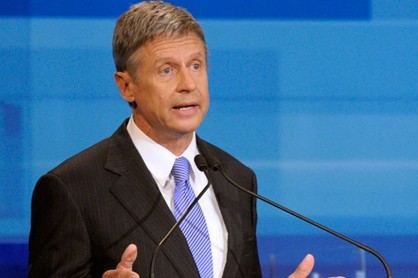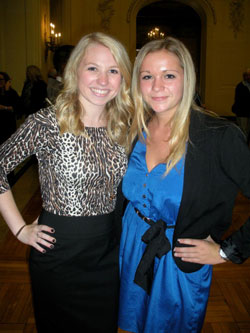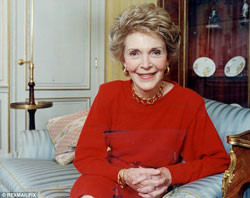As the country now finds itself in the thick of yet another presidential election cycle, the names of candidates Barack Obama and Mitt Romney are indelibly seared into the subconscious sentience of just about anyone who has turned on a television or logged into a computer over the past 12 months.
These candidates, for better or worse, have risen to the top of the American political sphere and have reduced the competition for the most powerful office on earth to simply one man pitted against the other.
The nature of a two-candidate race dictates that there be total focus devoted to the two men vying for the White House, but throughout this election season, there have been other candidates outside the mainstream who have thrown their hats into the ring that have not garnered the attention of the 24-hour media frenzy.
Two names that are likely to be known by college-aged voters are those of Texas Congressman Ron Paul and Libertarian Presidential nominee Gary Johnson. Both men have been able to drum up relatively large numbers of supporters despite their lack of media exposure, and many of the viewpoints shared by these candidates resonate with a considerable number of the younger sectors within the voting demographic who are looking to challenge the status-quo and have their voices heard for the first time.
Americans aged 18 to 24 typically lead fast-paced and somewhat chaotic lifestyles. Since many are in college or otherwise occupied, most young voters simply cannot be bothered by the political goings on; they have lives to live after all. Despite the diverse directions in which young people may be taken by their busy existences, a commonality amongst them all seems clear; young people tend to be fiercely independent, ambitious, and do not wish to be impeded by burdensome obligations and regulations.
Nicholas Waltman, a senior studying political science echoed this sentiment when asked about the priorities of young voters, “I think that people our age are discouraged by the status-quo and they feel like they are finally able to have a say in how the government is run.” Figures such as Ron Paul and Gary Johnson have managed to become popular among young voters for just those reasons; these candidates are also discouraged by the status-quo and offer compelling alternatives to the current state of affairs.
Paul has run for president on multiple occasions since 1988 when he was the nominee for the Libertarian Party. His talk of limited, strictly constitutional government and fiscal responsibility has proven attractive to voters of all demographics, but aimed squarely at young voters are his positions on many social issues.
The Congressman’s proposals such as lowering both individual and commercial tax rates could make it much easier for young people to find work in addition to leaving more money in their pockets and his proposal to end Selective Service registration could help young people to feel more secure in their future plans. Even more pertinent to young voters however is the congressman’s position on media, which calls for near-complete deregulation of many forms of communication such as television and radio as well as maintaining internet freedom.
As stated by Dr. Don Swanson, Chair of the Department of Philosophy, Religion, Interdisciplinary Studies, “Less than 30 percent of young voters get information from mainstream generally objective television news or newspaper reports” thus making any issue related to the internet or alternative media very important to young voters.
Johnson shares many viewpoints with Congressman Paul and is also an ardent proponent of fiscal conservatism and strictly constitutional government. Also, in addition to wanting to secure First Amendment rights in new forums such as the internet, Johnson also proposes the legalization of marijuana, online gambling, and proposes that the government take a neutral stance on morally controversial issues such as abortion and stem-cell research, all of which are extremely controversial and polarizing issues for mainstream Republican and Democrat candidates.
As if a strict opposition to the status- quo were not enough, these candidates’ use of alternative forms of communication such as social media has served to cement the support of many young voters.
Candidates such as Paul and Johnson have not enjoyed the same amount of media exposure as mainstream candidates, but given the scope of the alternative methods of communication that now exist, this is no longer quite as large a hindrance as it might have been only ten years ago. B oth candidates have used social media to great effect and Ron Paul’s campaign has seen its Facebook page accrue over 1 million followers. Given that over 1 million people support Paul for example, then why are alternative candidates not elected more frequently? Unfortunately, the answer is quite simple, young people are not engaged. According to the Pew Research Center, only 63 percent of young voters say that they “definitely plan” to vote this year and only 18 percent said that they follow election news “very closely.”
Yes, third parties do exist and yes, they do have large numbers of supporters, but there is a gross lack of unity among even different sectors within third parties, which translates into a fragmentation of message and an inability to unite behind any one particular galvanizing issue.
Dr. Charles Cotton, a professor of political science offered this when asked about the potential impacts of alternative presidential candidates, “Right now, there is no one unified third party and this is ultimately to the disadvantage of any nonmainstream candidate. They lack the support and resources needed to disseminate their position to the masses. Therefore, the current twoparty system is perpetuated.”
If not a third party, then perhaps what is needed for alternative candidates to gain momentum and relevance is the sort of grassroots ground swell which resulted in the addressing of issues such as civil rights and environmental protection.
In the 1960s and 1970s it was young people who mobilized in support of those issues and they were able to effect change with great success. As seen dramatically in 2011’s Occupy protests, young people still have the ability to organize en masse and command national attention. Although the message of the Occupy protests was fragmented at best, they did demonstrate that the nation’s youth are still a factor in political affairs and that when united on message, young people will be able to make their voices heard and help shape America as strides inexorably forward into the 21st century.
IMAGE TAKEN From usanews.com




